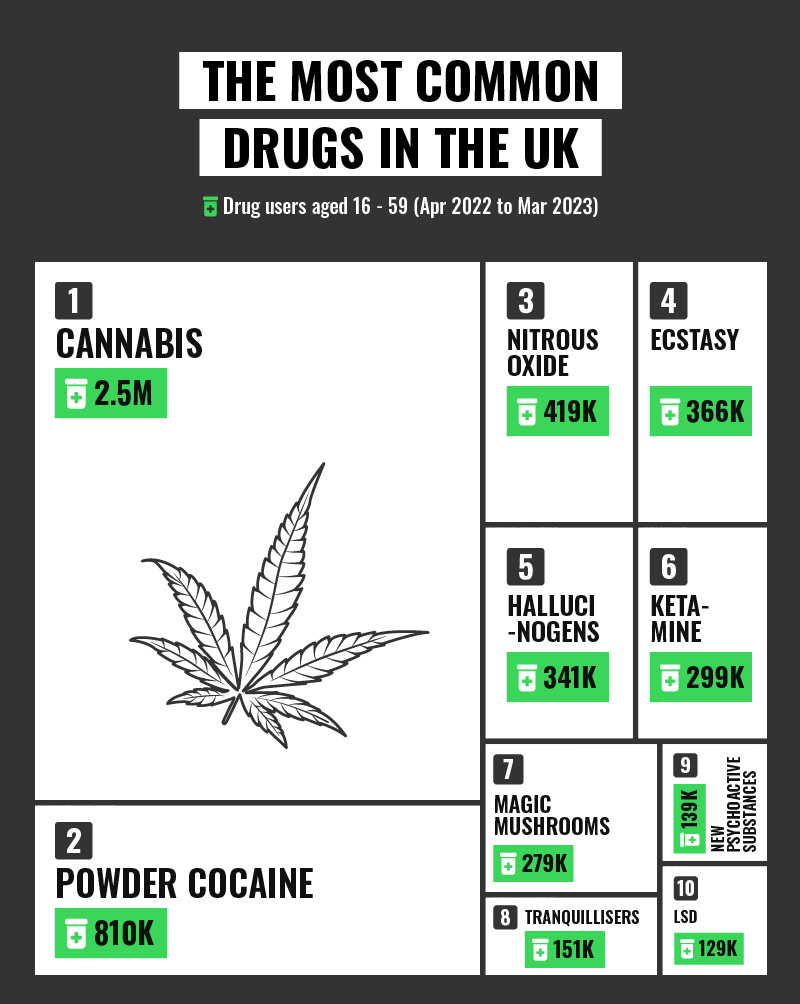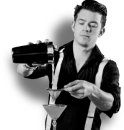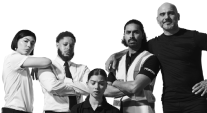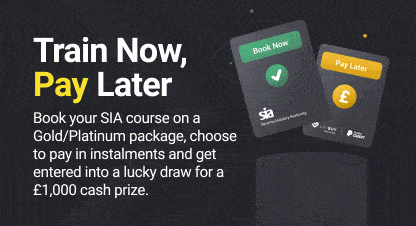UK Drug Misuse Report 2024: Trends, Statistics, Age Demographics, and Regional Drug Crime Analysis

Drug misuse in the UK is no longer a hidden problem—it’s a crisis impacting families, communities, and public safety. In 2022, nearly 5,000 people lost their lives to drug poisoning, and by 2023, over 770,000 people aged 16-59 reported regular drug use. These numbers aren’t just statistics; they’re a wake-up call.
In this report, we dive into the data to uncover the hard truths: which regions are facing the biggest challenges, which drugs are most commonly used, and how drug use is changing across the country. By understanding these trends, we can better address the root causes of drug misuse and work towards a safer, healthier future for everyone.
Using data from the Office for National Statistics (ONS), we’ve uncovered:
- The most common drugs in the UK
- Drugs with the highest increase in usage over the past decade
- Age groups most involved in drug use
- Regions with the highest number of drug-related crimes and those with the fastest growth in offences
With drug-related incidents on the rise in clubs, bars, and public spaces, the need for skilled, licensed security officers has never been greater. The Security Industry Authority (SIA) estimates that 60,000 new officers will be needed in the coming year alone to keep up with demand.
Let’s get into it: a clear look at the state of drug misuse in the UK—and what it means for all of us.
Most Commonly Used Drugs in the UK (2022-23)

- Cannabis
- Powder Cocaine
- Snorting: Provides a short-lived high lasting about 15-30 minutes
- Smoking or Injecting: Produces a more intense effect but lasts only 5-10 minutes.
- Nitrous Oxide (Laughing Gas)
Estimated Users (2022-23): 2.5 million
Cannabis remains the UK’s most widely used illegal drug, with 2.5 million people reporting use between April 2022 and March 2023. According to a 2024 survey, around 32% of people in Great Britain support legalising cannabis and other ‘soft’ drugs—a topic that continues to spark debate.
Although cannabis (also known as marijuana) is the most commonly used illicit drug worldwide, legalisation remains controversial. Critics argue that regular cannabis use can lead to tolerance, where users need more of the drug over time to achieve the same effects. This could potentially encourage some users to experiment with stronger, riskier substances.
Effects and Risks: Regular cannabis use is associated with mental health issues such as paranoia, depression, and, in severe cases, schizophrenia. These effects can interfere with daily life, affecting work, school, and personal relationships.
Estimated Users (2022-23): 810,000
Cocaine is the second most commonly used drug in the UK, with 810,000 users aged 16 to 59. In comparison, 33,000 people reported using crack cocaine, a more potent and addictive variant of the drug.
Effects and Risks: Cocaine impacts nearly every part of the body and can lead to serious, long-term health issues. Chronic use can alter brain structure, increase stress hormones, and reduce functionality in key areas of the brain. The way cocaine is consumed also affects the experience:
Many users take frequent doses to maintain the high, quickly leading to addiction due to cocaine’s effect on dopamine levels in the brain, making it exceptionally hard to quit.
Estimated Users (2022-23): 419,000
Nitrous oxide, commonly known as laughing gas or NOS, was used by approximately 419,000 people last year. This colourless gas, usually sold in small canisters, is often inhaled from balloons to achieve a short-lived euphoric effect. However, inhaling nitrous oxide directly from the canister is dangerous and can cause oxygen deprivation, leading to unconsciousness or even suffocation.
Effects and Risks: As of November 2023, nitrous oxide is classified as a Class C drug in the UK, making it illegal to possess, distribute, or sell. Prior to this ban, personal possession was not an offence, but the government introduced stricter regulations due to growing concerns over misuse and its impact on public health.
Drugs with the Highest Increase in Usage (2013-2023)


- Magic Mushrooms
- Ketamine
- LSD
Increase in Usage Since 2013: 182.5%
Magic mushrooms have seen an extraordinary rise in popularity, with usage increasing by nearly 183% across England and Wales in 2023. Currently, about 1 in 100 adults aged 16-59 reported using hallucinogens, with a significant number turning to magic mushrooms specifically.
Magic mushrooms are among the most well-known hallucinogens globally, with over 180 species identified. In the UK, the Liberty Cap variety is the most commonly used. Although classified as a Class A drug (alongside substances like heroin and crack cocaine), magic mushrooms are often perceived differently due to their natural origin and relatively low risk of addiction. However, they can still cause intense hallucinations and unpredictable psychological effects, making usage potentially dangerous.
Increase in Usage Since 2013: 148.7%
Ketamine usage has more than doubled over the past decade, with 0.9% of the population in England and Wales reporting usage in 2023, up from 0.4% in 2016. Initially developed as an anaesthetic and pain reliever for both humans and animals, ketamine has become popular in nightlife scenes for its hallucinogenic effects.
While medically useful, recreational use of ketamine carries serious risks. It is classified as a Class B substance in the UK, making it illegal to possess, distribute, or sell without a prescription. Recreational users quickly develop a tolerance, often needing higher doses to achieve the same effects. Chronic use can lead to severe health problems, particularly bladder damage. Frequent users may experience urinary issues, including infections, bleeding, and even incontinence, due to damage to the bladder lining.
Increase in Usage Since 2013: 141.9%
LSD (lysergic acid diethylamide), commonly known as “acid,” has also seen a sharp rise in use, with 0.4% of the UK population reporting use in 2023, up from 0.3% in 2020. LSD is a powerful psychedelic that can create intense visual and sensory distortions, mood shifts, and so-called “mystical experiences.” The effects of an LSD “trip” can last up to 12 hours and vary widely depending on the user’s environment and state of mind.
Risks of LSD Use: While LSD is known for its transformative, mind-altering experiences, it can also lead to “bad trips,” which may involve intense feelings of panic, confusion, and fear, along with disturbing visual or auditory hallucinations. Some users may even experience flashbacks or lingering psychological effects long after the drug has worn off. Because LSD affects judgement and perception, users may put themselves in risky situations, leading to potential harm or injury.
Age Groups Using Drugs the Most in the UK

Drug misuse rates vary significantly by age, with young adults showing the highest levels of use. Here’s a breakdown of the age groups most affected:
- 20-24 Years Old
- Cannabis: 16.1%
- Powder Cocaine: 6.9%
- Ketamine: 4.8%
- Hallucinogens: 3.6%
- 16-19 Years Old
- Cannabis: 14.3%
- Powder Cocaine: 2.7%
- Ketamine: 2.5%
- Hallucinogens: 1.7%
- 25-29 Years Old
- Cannabis: 11.2%
- Powder Cocaine: 3.8%
- Ketamine: 1.3%
- Hallucinogens: 1%
The 20-24 age group has the highest rate of drug use, with 18.4% reporting drug use in the past year. The most commonly used substances in this age group include:
Young adults in this age range are at a higher risk for experimentation, which may contribute to these elevated rates. Cannabis remains the top choice, but the significant use of cocaine, ketamine, and hallucinogens reflects changing recreational trends among this demographic.
Drug Users: 16.6%
The second highest rate of drug use is seen among 16-19-year-olds, with 16.6% reporting usage. This age group most frequently uses:
According to government findings from the 2022-23 Young People’s Substance Report, 12,418 individuals under 18 sought help from drug and alcohol services between April 2022 and March 2023, a 10% increase from the previous year. This data highlights a growing concern over early exposure to drug misuse, with many teens turning to services for support.
Drug Users: 15%
Among adults aged 25-29, 15% reported drug use in the past year. This figure is slightly lower than that of younger age groups but still significant. The most commonly used drugs in this age bracket include:
Cannabis remains the preferred drug, though cocaine and ecstasy are also prominent within this demographic, reflecting its association with social and nightlife settings.
Comparing Police-Recorded Drug Offences Across England and Wales

Drug-related offences in England and Wales have been on a steady rise over the past several years, reflecting a growing challenge for law enforcement. Here’s a breakdown of key trends and hotspots for drug offences across the UK.
Year-on-Year Trends in Drug Offences
- Steady Rise Since 2019: Drug offences first began spiking in the year ending March 2019, with an 11.5% increase. The upward trend continued into 2019/20, with drug-related crimes reaching 183,903 offences—a jump of over 19% from the previous year.
- Recent Increase in 2024: In the past year, drug offences have continued to rise, though at a slower rate. By March 2024, offences had increased by 1.09% compared to 2023, reaching a total of 181,421 incidents. This figure surpasses the 10-year average of 171,450 drug offences by nearly 10,000 cases.
These statistics highlight the persistent challenge of drug-related crime in the UK, with no sign of significant decline.
UK Areas with the Most Drug Offences in 2024
By analysing LG Inform data, we identified the local authorities with the highest number of drug offences per 1,000 people. This includes offences related to possession, production, trafficking, and distribution of illegal substances.

- Liverpool
- Manchester
- Bradford
Drug Offences: 12.1 per 1,000 people
Liverpool recorded the highest drug offence rate in the UK in 2024, with 12.1 incidents per 1,000 residents—more than five times the national average of 2.76 per 1,000. According to researchers at the University of West London, Liverpool’s drug crime rates are driven by high levels of poverty and a significant presence of drug trafficking networks, often intertwined with organised crime.
Drug Offences: 8.2 per 1,000 people
Manchester, another major urban centre in the North West, reported 8.2 drug offences per 1,000 people. This rate is nearly three times the national average. Manchester’s drug-related crime is concentrated in certain neighbourhoods and is often associated with social and economic challenges in the area.
Drug Offences: 4.19 per 1,000 people
Bradford, in West Yorkshire, had a drug offence rate of 4.19 per 1,000 people. In May 2024, a significant operation in Keighley, a town within Bradford, led to the arrest of over 60 individuals linked to County Lines drug networks. This large-scale operation reflects the ongoing efforts by law enforcement to address drug trafficking in the area.
UK Areas with the Highest Increase in Police-Recorded Drug Offences (2023-24)
Certain regions have not only high offence rates but also alarming year-on-year increases. Here are the areas with the fastest-growing rates of drug-related offences:

- Cambridgeshire
- Hampshire
- Lancashire
Increase in Offences: 145.96%
Cambridgeshire saw a staggering 145.96% rise in drug offences from December 2023 to March 2024. This increase was primarily driven by a surge in possession offences, a trend not observed on a national scale. The county now records 2.76 drug offences per 1,000 people, which is above the UK average. Local authorities attribute this rise to increased law enforcement focus on drug possession.
Increase in Offences: 12.31%
Drug offences in Hampshire grew by 12.31% over the past year, rising from 1.95 to 2.19 per 1,000 people by March 2024. In response, Hampshire and the Isle of Wight Constabulary held an “intensification week” focused on cracking down on drug gangs. The initiative led to the dismantling of 15 drug-dealing networks, 64 arrests, and safeguarding of 58 individuals. This proactive policing aims to address the root of the problem by tackling organised crime and protecting vulnerable people.
Increase in Offences: 8.61%
Lancashire recorded an 8.61% increase in drug offences in 2024, with the rate rising from 1.51 to 1.64 per 1,000 people. Local police report that over 2,600 people were arrested for drink or drug driving offences across the county in the last year, indicating a focus on policing drug-related driving offences as part of the broader effort to reduce drug crime.
Methodology
Data was sourced from:
- Office for National Statistics (ONS): Data on drug use and demographic breakdowns.
- Statista: Police-recorded drug offences data across England and Wales (2013-2024).
- LG Inform: Drug offences by local authority, analysed per 1,000 population.
These statistics highlight the persistent challenge of drug-related crime in the UK, with no sign of significant decline.
Sources
- Statista: Britain’s Cannabis Policy
- Government's Nitrous Oxide Ban Guidance
- ONS Young People’s Substance Misuse Report
- BDP on Magic Mushrooms
- Cambridgeshire Police Report
- Arrests for Drug Offences in England and Wales - Time Series (Statista)
- BBC News Article on Liverpool Gang Feuds
- Sky News Report on Liverpool's Feuding Gangs
- West Yorkshire Police Report: Over 60 Arrested in Huge Operation
Rising Demand for SIA-Licensed Security Officers Amid Increasing Drug-Related Incidents
With drug-related incidents rising across the UK, particularly in clubs, bars, and public venues, SIA-licensed security officers have become a necessity, not just an added layer of protection. The nightlife and hospitality sectors are especially vulnerable, as drug misuse poses serious safety risks to patrons and creates legal and reputational challenges for venue owners.
Given the current climate, the Security Industry Authority (SIA) estimates that 60,000 new security officers will be needed in the coming year to keep up with this growing demand. SIA-licensed officers are trained to manage high-risk situations, including handling drug-related incidents, deterring criminal behaviour, and ensuring public safety. Their presence is essential to creating safe environments where people can enjoy nightlife without fear.
Get Licensed: Training the Next Generation of Security Professionals
At Get Licensed, we’re committed to helping individuals become skilled, competent security officers ready to face today’s challenges. Our SIA-approved training courses—like the Door Supervisor Training Course—equip aspiring security professionals with practical skills in conflict resolution, drug awareness, and emergency response. This training prepares them for the realities of working in high-risk venues, from nightclubs to festivals.
With expert-led courses, flexible learning options, and nationwide availability, Get Licensed makes it easy to gain the qualifications needed to join the growing workforce of SIA-licensed security officers.
Ready to make an impact?
Visit Get Licensed to start your training and take the first step towards a rewarding and essential career in public safety.
Launch your career as a
Security Guard in the UK
Learn how to start your career in UK security industry.
Explore Courses

 Trustpilot
Trustpilot































